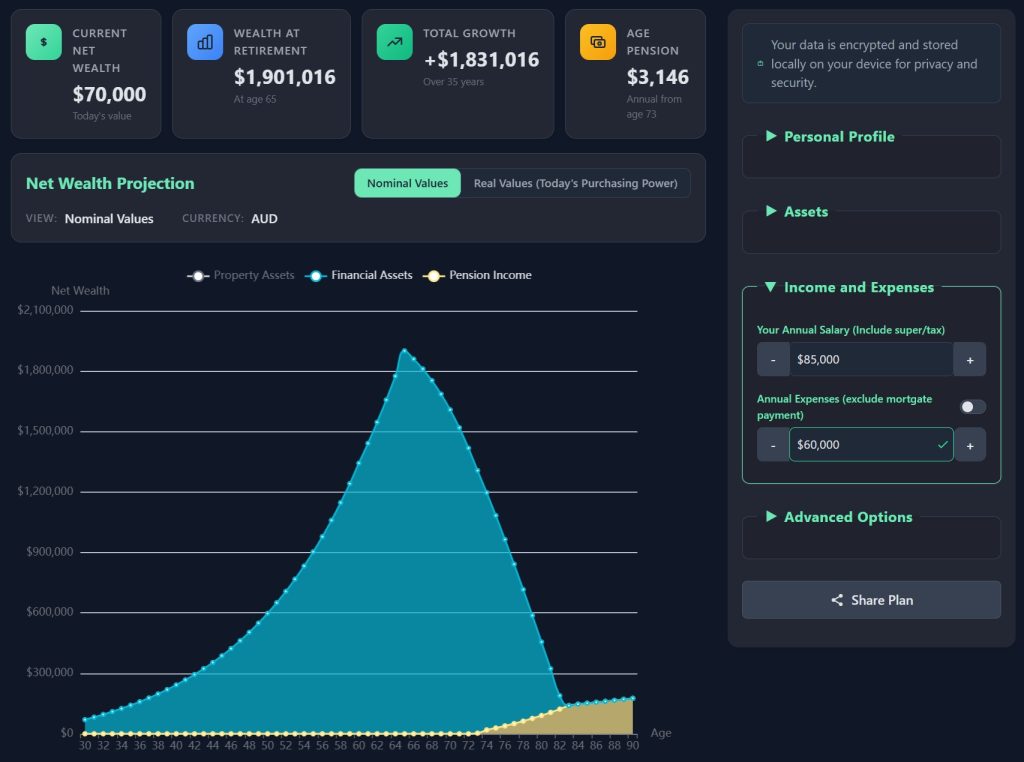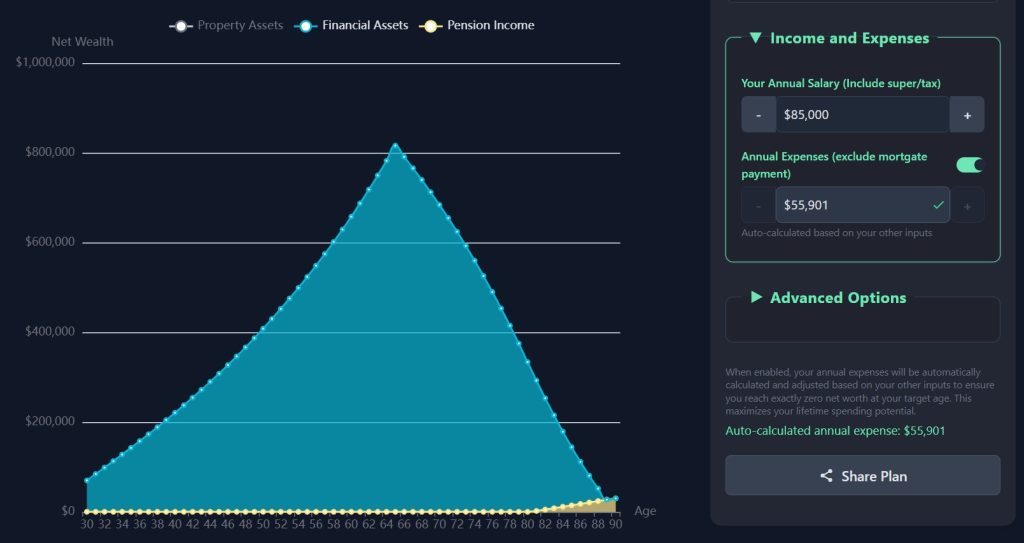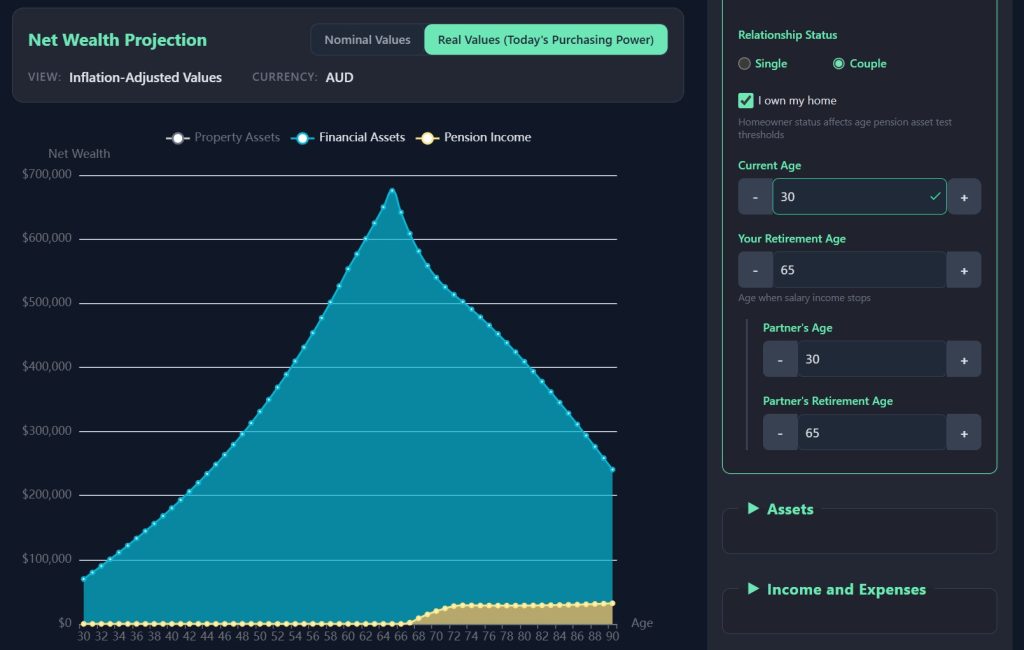Reality of Retirement Planning: What Every Australian Should Know
The Starting Point: Average Australian at 30
When it comes to retirement planning, most Australians in their thirties feel like they have plenty of time to worry about it later. But what happens when you actually run the numbers? I decided to test this assumption using a comprehensive retirement planning calculator with realistic Australian household data.
The Test Case:
- Age: 30 years old
- Current Savings: $25,000 (emergency fund and investments)
- Superannuation Balance: $45,000 (typical for someone who’s worked for 8-10 years)
- Annual Salary: $85,000 (close to Australian median income)
- Annual Expenses: $60,000 (reasonable living expenses)
- Homeowner: Yes (affects age pension eligibility)
The Stunning Result
The results were nothing short of remarkable and eye-opening:
Current Financial Position
- Current Net Wealth: $70,000 (savings + super)
- This represents a solid foundation for a 30-year-old Australian
Projected Retirement Wealth (Age 65)
- Total Wealth at Retirement: $1,901,016
- Total Growth: $1,831,016 over 35 years
- Age Pension Eligibility: $3,146 at 73 (partial pension due to assets test)
Screenshot showing the retirement projection for our average Australian household
The retirement calculation is done using Australian Retirement Planner
The Reality of Balanced Living
Year-by-Year Breakdown
- Age 31: Net assets grow to $82,507 (modest but steady growth)
- Age 40: Net assets reach $242,740 (quarter million by 40)
- Age 50: Net assets grow to $598,059
- Age 60: Net assets reach $1,343,466
The growth curve shows steady accumulation that peaks around age 65, then gradually declines as expenses exceed income during retirement years. Importantly, the wealth doesn’t run out until around age 85-86.
Key Insights from the Analysis
1. Starting Early Makes All the Difference
With just $70,000 starting wealth at the start of age 30, this individual projects to accumulate over $1.9 million by retirement. This demonstrates the solid foundation that starting your wealth-building journey in your twenties or thirties can provide.
2. Consistent Savings Rate is Critical
The projection assumes consistent saving and superannuation contribution. This may looks small in early days, but it’s what creates meaningful wealth accumulation while maintaining a comfortable lifestyle.
3. Superannuation is a Wealth-Building Powerhouse
By age 65, the superannuation balance reaches $1,901,016, which represents the entire retirement wealth in this scenario. This shows how superannuation truly forms the backbone of retirement wealth for most Australians when combined with consistent contributions.
4. Age Pension Provides a Safety Net
With $1,306,952 in assets, this individual qualifies for a partial age pension of $3,146 at age 73 and the pension grows. This demonstrates how the age pension asset test works on a sliding scale, providing some government support even for those with substantial retirement savings.
The Reality Check: What This Means
For Young Australians (20s-30s)
- Start now: Even small amounts invested consistently can grow to substantial sums
- Maximize super contributions: Take advantage of concessional contribution caps
- Focus on income growth: Higher earnings allow for higher savings rates
- Don’t underestimate expenses: The $60,000 expense figure assumes disciplined spending
For Middle-Aged Australians (40s-50s)
- It’s not too late: Even starting at 40 with lower balances can still yield significant results
- Consider catch-up contributions: Use available super contribution room
- Reassess spending: Every dollar saved and invested compounds significantly
For Those Approaching Retirement
- Understand asset tests: Moderate wealth may still qualify for partial age pension
- Plan withdrawal strategies: Consider how to efficiently draw down $2 million over retirement
- Factor in longevity: The projection shows wealth lasting until around age 85-86, so plan accordingly for potential longevity beyond this
The Caveats and Considerations
While these projections are encouraging, several important caveats apply:
1. Investment Returns Aren’t Guaranteed
The calculator assumes steady investment returns. e.g. 7% for super. Real-world returns fluctuate, and market downturns can significantly impact outcomes.
2. Inflation Impact
The projections show nominal values. In real purchasing power terms, $1.9 million in 35 years won’t buy what $1.9 million buys today. It is $675,590 in today’s value.
3. Life Happens
The projection assumes consistent annual savings for 35 years. Career breaks, health issues, property purchases, and family expenses can disrupt this consistency.
4. Changing Legislation
Superannuation rules, contribution limits, and age pension criteria change regularly. What applies today may not apply in 35 years.
Practical Steps to Start Your Retirement Journey
Immediate Actions (This Month)
- Calculate your current net wealth: Add up all assets minus debts
- Check your super balance: Log into your super fund and review performance
- Track your expenses: Understand where your money actually goes
- Set up automatic savings: Make wealth building systematic, not optional
Medium-term Goals (Next 12 Months)
- Optimize your super: Consider salary sacrificing to maximize contributions
- Build an emergency fund: Ensure you have 3-6 months of expenses saved
- Increase your savings rate: Aim to save at least 20% of gross income
- Educate yourself: Learn about investing, super strategies, and tax optimization
Long-term Strategy (Ongoing)
- Regular reviews: Annual check-ins to assess progress and adjust strategies
- Professional advice: Consider consulting a financial planner for personalized strategies
- Stay disciplined: Maintain consistent saving and investing habits
- Adapt to changes: Adjust plans as life circumstances and goals evolve
The Bottom Line
The retirement planning calculator test reveals both an inspiring possibility and a realistic roadmap. Yes, it’s entirely possible for an average Australian to accumulate over $2 million for retirement through consistent saving and disciplined spending. However, it requires consistent savings and realistic expectations about retirement lifestyle.
The key takeaway isn’t that everyone can retire with decent savings —it’s that starting early, saving consistently, and understanding the fundamentals of wealth building can provide a comfortable retirement. The projection shows you can maintain your lifestyle for about 20 years of retirement, which aligns well with average life expectancy.
Whether you’re 25 or 55, the best time to start serious retirement planning is now. The earlier you begin, the more compound growth works in your favor. But even if you’re starting later, the principles remain the same: save consistently, invest wisely, and let time work its magic.
Your future self will thank you for taking action today.
Extra Experiments.
If reduce spending to $55,901, the net asset remain positive until the age of 90.
If it’s a couple, a real comfortable retirement is possible thanks to the pension increase. If you are still single, you better think again.
This analysis is for educational purposes only and doesn’t constitute financial advice. Individual circumstances vary, and you should consider seeking professional financial advice tailored to your specific situation. The simulation is done using the calculator: Australian Retirement Planner | Free Financial Planning Calculator with Age Pension Integration


